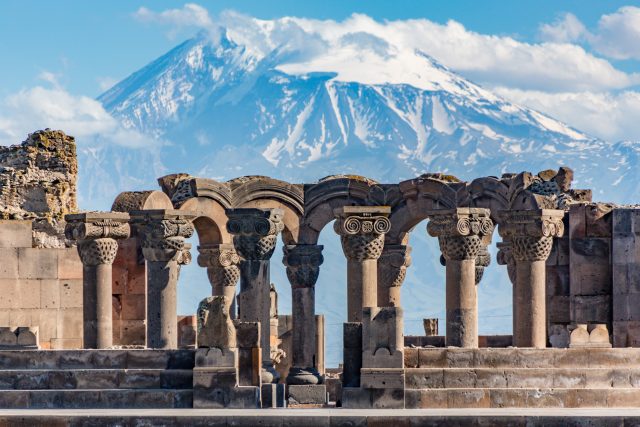This website uses cookies so that we can provide you with the best user experience possible. Cookie information is stored in your browser and performs functions such as recognising you when you return to our website and helping our team to understand which sections of the website you find most interesting and useful.
Armenia fizz is coming of age
It may have taken 8,000 years but Armenian sparkling wine is having a moment, writes L.M Archer.

Legend claims that Noah’s Ark landed on Mount Ararat near Armenia, carrying wine vines onboard. Later, an archaeological dig adjacent to the Armenian town of Areni uncovered Bronze Age artefacts dating back to 5000-4000 B.C., which experts believe belonged to the world’s oldest winery.
Sadly, this ancient wine heritage halted during Russian control over Armenia during the 20th Century when Russians ripped out native grape varieties, replacing them with high-yielding, non-native grapes earmarked for brandy production.
However, after the Soviet government’s collapse in 1991, Armenia gained independence. Isolation from the west ended, ushering in a wine renaissance.
Many members of the Armenian diaspora returned in the post-Soviet era, some intent upon revitalising its wine sector.
“What we’re really seeing in Armenia is that they are using modern technology, and modern methods, to really understand their grape varieties, and express the purity of their varieties in their terroirs,” says Master of Wine Lisa Granik, leading authority on the Caucusus, and consultant for Storica Wines, an Armenian wine importer to the US.
Entrepreneur and Italian winery owner Vahe Keushguerian, the subject of SOMM TV’s most recent film, Somm: Cup of Salvation, joined this influx. The businessman relocated to Armenia from Italy following a 1997 visit. Encouraged by Armenia’s winemaking potential, he founded the WineWorks crush facility in the early 2000’s. Many credit his company for helping jumpstart Armenia’s wine rebirth.
Today, Armenia boasts more than 200 wine producers, up from about 30 in 2015.
Vineyard plantations span six wine regions: Armavir, Ararat, Aragatsotn ,Tavush, Vayots Dzor, and Yerevan. Grapes include more than 400 native varieties, most notably Areni, Haghtanak, Voskehat, and Kangoun.
A country of extreme terrains, more than 70% of Armenia’s landscape is comprised of mountains. Average vineyard elevations are 1,500 metres (4,921 ft) above sea level, consisting predominately of limestone and volcanic soils.
“We’re just started to scratch the surface,” says Keushguerian. “So anybody who gets into the wine industry now will have opportunities that will not be available 10 years from now.”
Sparkling future
Keushguerian established Keush sparkling winery in 2013, after discovering an abandoned vineyard in the village of Khachik in in Vayots Dzor.
Local villagers carefully tend the 30ha plot of 100+ year old Areni vines for production of Armenia’s first traditional method fizz made from indigenous grapes. As a grape variety Areni offers nuanced aromas, appealing red berry and orchard fruit notes, and complexity to the finished wines.
“We work with Areni because it has thrived in our soils for thousands of years, and had been passed down through generations,” says Aimee Keushguerian, who joined her father at Keush in 2016, and later founded Zulal winery.
”It is endemic to our territory, and is unlike any other grape variety in the world.”
The Vayots Dzor vineyard perches 1,750 metres (5,741 feet) above sea level in southeastern Armenia, overlooking boundaries between neighbouring Azerbaijan, Georgia, Turkey, and Iran.
Cool, high elevations contribute to bright acidity in the grapes, a crucial component for crafting quality sparkling wine.
“In Khachik Village, we are able to grow it at extreme elevations, and still achieve a balance of acidity and roundness that we look for in our sparkling wines, “ Keushguerian adds.
Currently, less than five winemakers produce Armenian sparkling wine. But that may be changing.
The country produces 50,000 bottles annually, which is expected to shoot up to 200,000 bottles per year by 2026.
According to Statista, Armenia’s sparkling wine market revenues will reach US$1.96 million in 2023, with anticipated CAGR (Compound Annual Growth Rate) of 3.28% between 2023-2027.
Export markets include Europe, Canada, and the US, with average retail prices ranging between US$39.99-US$42.99.
Meanwhile, as exports grow, as do talks of forming an Armenian Wine Board. Despite the hotbed geo-political neighbourhood, the future of Armenian sparkling wine looks promising, indeed.

